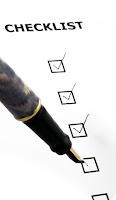
Teams Using “Cheat Sheets” Always Produce Better Results
There was a recent story in the Washington Post by Ceci Connolly claiming that surgical teams following a basic cockpit-style checklist in the operating room, from confirming the patient's name to discussing expected blood loss, reduced the rate of deaths and complications by more than a third. I claim that your sales “death rate” can also drop dramatically if you take a lesson from pilots and now, surgeons, and use a checklist of your own during sales calls.
Connolly’s theory is that the human brain can't remember everything, so it's best to focus on the complicated challenges and leave the simple reminders to a cheat sheet. A salesman’s checklist is a cheat sheet...a basic form of pre-call planning. The sales call can get intense and dynamic. The professional salesperson must focus 100% on what the customer is saying. Listening skills are a salesperson’s most important attribute. You can’t listen effectively if your brain is working overtime to think of the next question you want to ask, or trying to figure out how to get the sales call back on the road and out of the ditch. Here are some ideas:
-Plan and write down your opening statement. Make it a “killer” question or phrase that grabs attention and focuses the client on the problem.
-Ask why it is important to solve this problem.
-Uncover the decision criteria. Rank them in order of importance.
Connolly’s theory is that the human brain can't remember everything, so it's best to focus on the complicated challenges and leave the simple reminders to a cheat sheet. A salesman’s checklist is a cheat sheet...a basic form of pre-call planning. The sales call can get intense and dynamic. The professional salesperson must focus 100% on what the customer is saying. Listening skills are a salesperson’s most important attribute. You can’t listen effectively if your brain is working overtime to think of the next question you want to ask, or trying to figure out how to get the sales call back on the road and out of the ditch. Here are some ideas:
-Plan and write down your opening statement. Make it a “killer” question or phrase that grabs attention and focuses the client on the problem.
-Ask why it is important to solve this problem.
-Uncover the decision criteria. Rank them in order of importance.
-What is the decision process? Who is involved? (Get introduced to the people you don’t know that have a role in making it happen).
-Has the budget been approved?
-Which other solution providers are competing?
-Interest rate being used to arrive at NPV and IRR
-Carrying cost of inventory/Cost of capital
-Other financial ground rules?
I think you get the idea. Write them all down. If you are involved in complex sales for expensive things, it’s likely that you make sales calls with a team of subject matter experts. Involve them in the checklist planning and execution. That way the team stays more coordinated during the call.
You will get the most out of your sales call checklist if you build it around the potential problems that the customer may be having. Most problems tend to fall into what I call my “basic dozen categories”. Here they are:
-Has the budget been approved?
-Which other solution providers are competing?
-Interest rate being used to arrive at NPV and IRR
-Carrying cost of inventory/Cost of capital
-Other financial ground rules?
I think you get the idea. Write them all down. If you are involved in complex sales for expensive things, it’s likely that you make sales calls with a team of subject matter experts. Involve them in the checklist planning and execution. That way the team stays more coordinated during the call.
You will get the most out of your sales call checklist if you build it around the potential problems that the customer may be having. Most problems tend to fall into what I call my “basic dozen categories”. Here they are:
1) Profitability
2) Cost
3) Productivity
4) Competition
5) Quality
6) Ease of Operation
7) Reliability
8) Credibility
9) Safety
10) Morale
11) Customer Satisfaction
12) Reputation/image
Think of the basic dozen as a “checklist for a checklist”. Build your checklist around these categories and your sales call death rate will decrease dramatically.
Good selling!!
1 comment:
Steve,
Nicely done blog - it inspires me to consider something similar. It's interesting to note you spent the week in Istanbul. Did you get down to the bazaar while you were there? Now that is a place where the art of selling has been practiced very aggressively for a few thousand years:-)! I wonder if there might be some lessons learned that would be applicable?
Good luck in the very challenging year ahead.
Ken Honeycutt AMP 169
Post a Comment